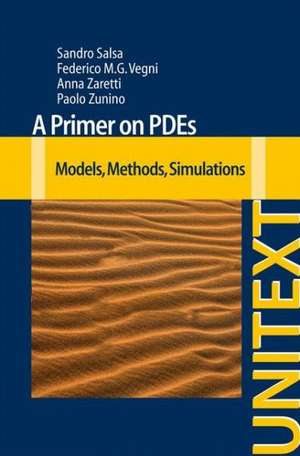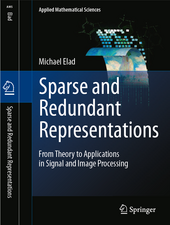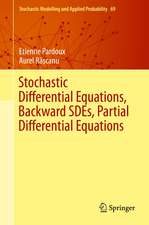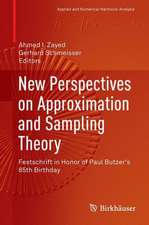A Primer on PDEs: Models, Methods, Simulations: UNITEXT
Autor Sandro Salsa, Federico Vegni, Anna Zaretti, Paolo Zuninoen Limba Engleză Paperback – 22 ian 2013
Din seria UNITEXT
-
 Preț: 458.61 lei
Preț: 458.61 lei - 17%
 Preț: 402.50 lei
Preț: 402.50 lei -
 Preț: 403.82 lei
Preț: 403.82 lei -
 Preț: 434.06 lei
Preț: 434.06 lei - 20%
 Preț: 571.54 lei
Preț: 571.54 lei -
 Preț: 277.32 lei
Preț: 277.32 lei - 13%
 Preț: 427.17 lei
Preț: 427.17 lei -
 Preț: 335.81 lei
Preț: 335.81 lei -
 Preț: 283.76 lei
Preț: 283.76 lei -
 Preț: 271.54 lei
Preț: 271.54 lei -
 Preț: 361.12 lei
Preț: 361.12 lei -
 Preț: 221.27 lei
Preț: 221.27 lei -
 Preț: 345.56 lei
Preț: 345.56 lei -
 Preț: 455.00 lei
Preț: 455.00 lei -
 Preț: 393.99 lei
Preț: 393.99 lei -
 Preț: 459.92 lei
Preț: 459.92 lei - 17%
 Preț: 364.75 lei
Preț: 364.75 lei -
 Preț: 365.15 lei
Preț: 365.15 lei - 17%
 Preț: 363.85 lei
Preț: 363.85 lei -
 Preț: 329.06 lei
Preț: 329.06 lei -
 Preț: 358.93 lei
Preț: 358.93 lei -
 Preț: 352.80 lei
Preț: 352.80 lei -
 Preț: 348.27 lei
Preț: 348.27 lei -
 Preț: 242.17 lei
Preț: 242.17 lei - 15%
 Preț: 789.30 lei
Preț: 789.30 lei -
 Preț: 295.90 lei
Preț: 295.90 lei - 15%
 Preț: 560.69 lei
Preț: 560.69 lei -
 Preț: 426.72 lei
Preț: 426.72 lei -
 Preț: 450.33 lei
Preț: 450.33 lei -
 Preț: 357.43 lei
Preț: 357.43 lei - 17%
 Preț: 361.97 lei
Preț: 361.97 lei -
 Preț: 551.87 lei
Preț: 551.87 lei -
 Preț: 414.65 lei
Preț: 414.65 lei -
 Preț: 221.87 lei
Preț: 221.87 lei -
 Preț: 460.91 lei
Preț: 460.91 lei -
 Preț: 434.34 lei
Preț: 434.34 lei -
 Preț: 263.28 lei
Preț: 263.28 lei -
 Preț: 192.44 lei
Preț: 192.44 lei -
 Preț: 379.48 lei
Preț: 379.48 lei -
 Preț: 497.96 lei
Preț: 497.96 lei -
 Preț: 240.26 lei
Preț: 240.26 lei -
 Preț: 381.98 lei
Preț: 381.98 lei -
 Preț: 326.72 lei
Preț: 326.72 lei -
 Preț: 432.58 lei
Preț: 432.58 lei -
 Preț: 325.20 lei
Preț: 325.20 lei -
 Preț: 269.60 lei
Preț: 269.60 lei -
 Preț: 496.35 lei
Preț: 496.35 lei -
 Preț: 329.83 lei
Preț: 329.83 lei -
 Preț: 249.89 lei
Preț: 249.89 lei -
 Preț: 364.56 lei
Preț: 364.56 lei
Preț: 486.26 lei
Preț vechi: 572.06 lei
-15% Nou
Puncte Express: 729
Preț estimativ în valută:
93.05€ • 101.39$ • 78.40£
93.05€ • 101.39$ • 78.40£
Carte tipărită la comandă
Livrare economică 23 aprilie-07 mai
Preluare comenzi: 021 569.72.76
Specificații
ISBN-13: 9788847028616
ISBN-10: 8847028612
Pagini: 504
Ilustrații: XIV, 489 p.
Dimensiuni: 155 x 235 x 32 mm
Greutate: 0.84 kg
Ediția:2013
Editura: Springer
Colecția Springer
Seriile UNITEXT, La Matematica per il 3+2
Locul publicării:Milano, Italy
ISBN-10: 8847028612
Pagini: 504
Ilustrații: XIV, 489 p.
Dimensiuni: 155 x 235 x 32 mm
Greutate: 0.84 kg
Ediția:2013
Editura: Springer
Colecția Springer
Seriile UNITEXT, La Matematica per il 3+2
Locul publicării:Milano, Italy
Public țintă
Upper undergraduateCuprins
Introduction.- Scalar Conservation Laws.- Diffusion.- The Laplace Equation.- Reaction-diffusion models.- Waves and vibrations.- Elements of Functional Analysis.- Variational formulation of elliptic problems.- Weak formulation of evolution problems.- Solutions.- Fourier Series.- Notes on ordinary differential equations.- Finite difference approximation of time dependent problems.- Identities and Formulas.
Recenzii
From the book reviews:
“This book, presented at the advanced undergraduate or first year graduate level, takes a very interesting mixed approach to partial differential equations, shining a modern light on a classic subject. In addition to the usual analytic solution methods, the presentation includes both numerical approaches and mathematical techniques for proving rigorous existence and regularity results. … Each chapter concludes with an informative set of exercises, and solutions to many of them are provided at the end of the book.” (Peter Bernard Weichman, Mathematical Reviews, May, 2014)
“The present text is suitable for a two semester introduction to partial differential equations. … The text is well-written and can be particularly recommended for students who are interested in the interplay between modeling, theory, and numerics.” (G. Teschl, Monatshefte für Mathematik, 2013)
“Part I (Chapters 2–6) of this book … is entitled Differential models. … Part II (Chapters 7–9) is entitled Functional analysis techniques for differential problems and it is devoted to Hilbert space methods for the variational formulation and the analysis of linear boundary and initial-boundary value problems. … at the end of each chapter the authors include a brief account of numerical methods, with a discussion of some particular case study. … recommend this book to students in engineering, applied mathematics and physics.” (Vicenţiu D. Rădulescu, zbMATH, Vol. 1270, 2013)
“This book, presented at the advanced undergraduate or first year graduate level, takes a very interesting mixed approach to partial differential equations, shining a modern light on a classic subject. In addition to the usual analytic solution methods, the presentation includes both numerical approaches and mathematical techniques for proving rigorous existence and regularity results. … Each chapter concludes with an informative set of exercises, and solutions to many of them are provided at the end of the book.” (Peter Bernard Weichman, Mathematical Reviews, May, 2014)
“The present text is suitable for a two semester introduction to partial differential equations. … The text is well-written and can be particularly recommended for students who are interested in the interplay between modeling, theory, and numerics.” (G. Teschl, Monatshefte für Mathematik, 2013)
“Part I (Chapters 2–6) of this book … is entitled Differential models. … Part II (Chapters 7–9) is entitled Functional analysis techniques for differential problems and it is devoted to Hilbert space methods for the variational formulation and the analysis of linear boundary and initial-boundary value problems. … at the end of each chapter the authors include a brief account of numerical methods, with a discussion of some particular case study. … recommend this book to students in engineering, applied mathematics and physics.” (Vicenţiu D. Rădulescu, zbMATH, Vol. 1270, 2013)
Textul de pe ultima copertă
This book is designed as an advanced undergraduate or a first-year graduate course for students from various disciplines like applied mathematics, physics, engineering. It has evolved while teaching courses on partial differential equations during the last decade at the Politecnico of Milan. The main purpose of these courses was twofold: on the one hand, to train the students to appreciate the interplay between theory and modelling in problems arising in the applied sciences and on the other hand to give them a solid background for numerical methods, such as finite differences and finite elements.
Caracteristici
This minimal knowledge on numerical approximation schemes represents an useful tool for training on model applications Numerical simulations help to put into action and visualize the theoretical properties of the models that will be analysed Each chapter ends with a brief introduction to numerical approximation techniques for the specific problem at hand Includes supplementary material: sn.pub/extras












